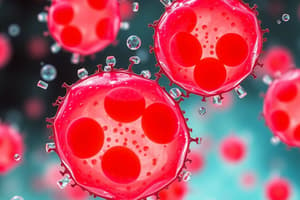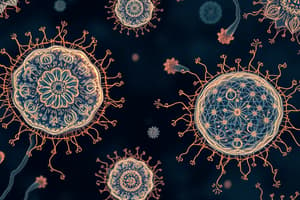Podcast
Questions and Answers
What is the main difference between prokaryotic and eukaryotic cells?
What is the main difference between prokaryotic and eukaryotic cells?
- The shape of the DNA molecule
- The number of cells in the organism
- The presence of a nucleus (correct)
- The presence of a cell wall
What is the function of the cell membrane?
What is the function of the cell membrane?
- To protect the cell from its environment
- To provide structural support
- To regulate the flow of materials in and out of the cell (correct)
- To house the DNA molecule
What is the shape of the DNA molecule in prokaryotic cells?
What is the shape of the DNA molecule in prokaryotic cells?
- Helical
- Linear
- Circular (correct)
- Spiral
What is the function of the nucleoid region in prokaryotic cells?
What is the function of the nucleoid region in prokaryotic cells?
What is the primary difference between prokaryotic and eukaryotic cell size?
What is the primary difference between prokaryotic and eukaryotic cell size?
What is the function of flagella in prokaryotic cells?
What is the function of flagella in prokaryotic cells?
What is the primary function of the cell wall?
What is the primary function of the cell wall?
When did eukaryotic cells first appear on Earth?
When did eukaryotic cells first appear on Earth?
Study Notes
Cell Classification
- Cells on Earth are categorized into two groups: prokaryotic cells and eukaryotic cells.
Prokaryotic Cells
- Prokaryotes were the first cells to appear on the planet.
- All prokaryotes are single-celled.
- Examples of prokaryotes include bacteria and archaea.
- Prokaryotes are smaller cells that lack a nucleus and membrane-bound organelles.
- DNA in prokaryote cells is circular, looping around itself like a rubber band, and found in the nucleoid region.
Eukaryotic Cells
- Eukaryotic cells emerged 1.5 billion years after prokaryotes.
- The main difference between prokaryotes and eukaryotes is the presence of a central control structure, the nucleus, where DNA is housed.
- Examples of eukaryotes include plants, animals, and fungi.
- Eukaryotic cells can be part of multicellular organisms or single-celled organisms.
- DNA in eukaryotic cells is linear, with ends, like a piece of spaghetti.
Common Cell Structures
- All cells have a cell membrane, which surrounds and defines the inner environment of the cell.
- The cell membrane is composed of a phospholipid bilayer with proteins and additional components.
- All cells also have ribosomes and cytoplasm.
Additional Cell Structures
- Some prokaryotes and eukaryotes have a protective cell wall, a rigid structural support outside the cell membrane.
- Some cells have external appendages, such as cilia and flagella, which help with movement.
- Flagella are long extensions that move back and forth to facilitate cell movement, as seen in sperm cells.
Studying That Suits You
Use AI to generate personalized quizzes and flashcards to suit your learning preferences.
Description
Learn about the two main categories of cells, prokaryotic and eukaryotic cells, and their characteristics. Understand the differences between these two cell types.




